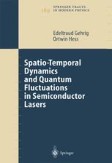Search
Search Results
-
Monolithic Silicon Light Sources
Monolithic silicon light sources (LEDs and lasers) could have a significant impact when integrated on silicon chips. After a general introduction to...
-
5. Simulation of Active and Nonlinear Photonic Nano-Materials in the Finite-Difference Time-Domain (FDTD) Framework
A numerical method is presented that unites three-dimensional finite-differnce time-domain (FDTD) computer simulations of active, nonlinear photonic...
-
Results for Sr2RuO4
In this chapter, we focus on our results for the elementary excitations and Cooper pairing in strontium ruthenate (...
-
Silicon Fundamentals for Photonics Applications
The many and diverse approaches to materials science problems have greatly enhanced our ability to engineer the physical properties of...
-
Monolithic Silicon Microphotonics
The technology evolution of optical interconnection is driven by the distance × product required for a given link. As such optical fiber deployment...
-
13. Parallel Implementation Strategiesfor Algorithms from Scientific Computing
Many applications from scientific computing are computationally intensive and can therefore benefit from a realization on a parallel or a distributed...
-
Theory of Cooper Pairing Due to Exchange of Spin Fluctuations
It is of general interest whether singlet high- \(T_{\rm c}\)...
-
Concluding Remarks
So far, the 3DXRD microscope has mainly been applied to fundamental studies in metallurgy. As demonstrated in Chap. 9, the method is sufficiently...
-
The 3DXRD Microscope
The 3DXRD microscope at ESRF is installed in a separate laboratory, the second experimental hutch at beamline ID11 [1,2]. The beamline is an...
-
Applications
An understanding of polycrystalline deformation is essential for science and industry, in order to predict the development of texture and flow stress...
-
Anisotropic Substrates
A prerequisite for infrared ellipsometry investigations of semiconductor layer structures is an accurate knowledge of the substrate materials’...
-
The Active Carrier Plasma: Ultrafast Microscopic Dynamics and Spatio-Spectral Gratings
In this chapter we will analyze the dynamic physical processes in the active charge carrier plasma of a semiconductor laser. Calculation and...
-
General Aspects of Nuclear Resonant Scattering
Nuclear resonant scattering (NRS) unites a number of different scattering processes that can be used to investigate properties of condensed matter....
-
4 × 4 Transfer Matrix T p for Dielectric Helical Films
Dielectric helical thin films (DHTF’s) are described by a homogeneous rotation of an arbitrarily oriented symmetric dielectric function tensor ɛ...
-
Polaritons in Semiconductor Layer Structures
The infrared optical response of layered structures composed of polar semiconductor materials is strongly influenced by resonant excitation of...
-
Infrared Model Dielectric Functions
This chapter reviews a selection of dielectric function models progressed for lineshape analysis of (far) infrared ellipsometry data. Contributions...
-
Coherent Elastic Nuclear Resonant Scattering
In the field of x-ray diffraction, the intensity and the direction of scattered waves are determined by the properties of the individual scatterers...
-
Combining 3DXRD and Absorption Contrast Tomography
The 3DXRD setup sketched in Fig. 3.1 is very similar to the setup typically used for absorption contrast x-ray tomography at synchrotrons....
-
Multigrain Crystallography
Traditionally, x-ray crystallography is based on either powder diffraction data or single-crystal studies. Both methods have their distinct...
-
Introduction
The scattering of x-rays is a very powerful tool to investigate the structure and dynamics of condensed matter. The research in this field can be...
